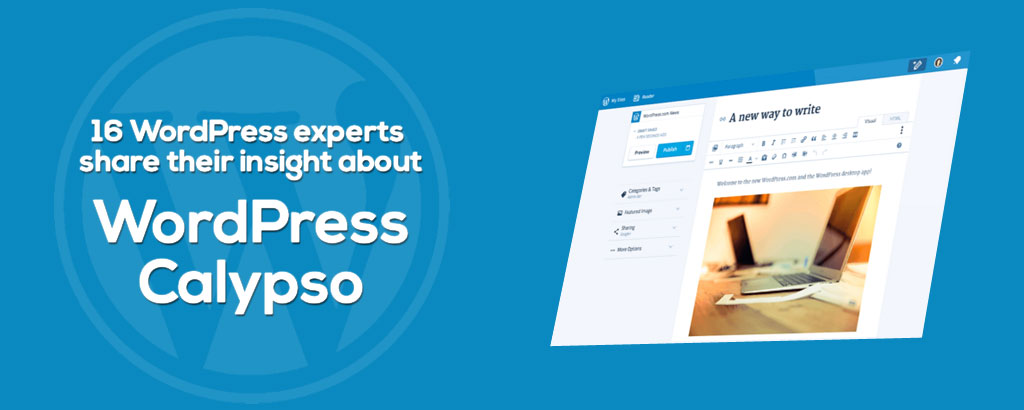- PSD to WordPress
-

- Learn
-

- Expert roundups
-

- 16 WordPress experts share their insight about the new WordPress Calypso
16 WordPress experts share their insight about the new WordPress Calypso
 Note: This article is not a review about the new features that come with Calypso. There are already enough other great articles that wrote about Calypso's features.
Note: This article is not a review about the new features that come with Calypso. There are already enough other great articles that wrote about Calypso's features.
Let me be honest. Other than what has already been written on other blogs, I don’t have much to say about Calypso since I’m not a WordPress.com expert. Every day, me and my team build custom WordPress.org themes, which our clients install on their self-hosted WordPress websites. On November 23, I saw Matt Mullenweg’s post about the release of Calypso. After reading it, I thought that WordPress was moving from PHP/MySQL to JavaScript. I just couldn’t believe it, so I did some digging on the topic. Soon I found out that Matt was referring to WordPress.com's Calypso and I completely misinterpreted the news, and many others along with me.
I do want to provide you with some general information about Calypso, in case you have missed. But before we dive into Calypso, let’s first get on the same page by pointing out some facts that confuse many people:
- Calypso is not a part of WordPress;
- The WordPress PHP/MySQL back-end is not being replaced with JavaScript;
- WordPress.com and WordPress.org are two entire different things.
What is WordPress Calypso?
 Calypso is the new open source WordPress.com admin interface, that basically allows you to easily manage your WordPress.com blogs. In comparison with the previous admin interface, Calypso is faster, a lot faster. Speed being the most important feature, Calypso comes with more features like a newly designed, clean interface, responsive behavior, real time updates, managing multiple sites, social integration, following other sites (RSS), desktop apps, and usage of the Jetpack plugin to use the Calypso interface on your self-hosted WorPress site.
Calypso is the new open source WordPress.com admin interface, that basically allows you to easily manage your WordPress.com blogs. In comparison with the previous admin interface, Calypso is faster, a lot faster. Speed being the most important feature, Calypso comes with more features like a newly designed, clean interface, responsive behavior, real time updates, managing multiple sites, social integration, following other sites (RSS), desktop apps, and usage of the Jetpack plugin to use the Calypso interface on your self-hosted WorPress site.
How does Calypso work?
Calypso is a front-end interface, built using JavaScript (and libraries like React and Node), that is designed to communicate via the WordPress.com REST API (which is open source), to the WordPress PHP/MySQL back-end. The WordPress.com API provides and consumes raw JSON data, which is consumed and provided via Calypso. In other words; the WordPress.com server provides the raw JSON data, which Calypso consumes via the API, and vice versa.
How do users and the community respond to Calypso?
Since the release of the editor, there are many people complaining about the new editor. There is a topic on the WordPress.com forum specially made for complaining about Calypso, called ‘Editor Feedback’, which currently has 25(!) pages filled with feedback and complaints. Lorelle VanFossen gave me the great idea to list some of these comments, but there are so many, that I’ll stick to one that in my opinion embraces a lot of those comments:
All I want to do is continue with my blog as it is now. I don't appreciate other people deciding that the process should be changed.
Just like me, many other people misinterpreted the news about Calypso and thought PHP/MySQL was going to be replaced with JavaScript. Since so many people had misinterpreted this news, I got curious about what Calypso actually is, how it works, and what the benefits of it are. Since I only work with WordPress.org and don’t do much with WordPress.com, I decided to ask 16 WordPress experts for their opinion about Calypso by asking them the following questions:
- What is your opinion about Calypso (experience/advantages/disadvantages) and how do you think applications like Calypso will affect the future of publishing online?
- What do you think about WordPress.com using JavaScript only for Calypso?
- Optional, if you’re using the open source version of WordPress.org: What do you think about integrating Calypso in your self-hosted WordPress website using the Jetpack plugin, and will you start using this on your own self-hosted WordPress websites?
Let’s hear what the actual WordPress experts have to say about Calypso!
16 WordPress Experts
Quickly find the 16 alphabetically ordered WordPress experts and their opinion about Calypso.
- A:
- B:
- D:
- F:
- G:
- J:
- K:
- L:
- M:
- P:
- T:
- W:
The 16 WordPress experts and their insights about Calypso
Lorelle VanFossen
Lorelle on WordPress
JavaScript as the Core of WordPress
WordPress.com has been the testing and proving ground for WordPress development since its inception. While many initially rejected WordPress.com down as for novices and unprofessional sites, I was among the few explaining that if you want to see what WordPress will become, living on the cutting edge of WordPress development, get a site on WordPress.com and use it - constantly. As a testing community, what a great opportunity to not only do wide spread or limited and isolated testing of new features and development but the richness in breath and width of testing environments is exceptional. Testing out a new core programming environment on WordPress.com portends the future of WordPress in general. Be warned, self-hosted version users. If this works with WordPress.com, it is coming your way.
As for the specifics of appreciating this change in the core programming environment from PHP and MySQL to JavaScript with React and Node.js, this isn't a completely new approach. I've worked with many in the WordPress development community branching out versions of all Java, all Flash, flat databases, and other deviations. All of those failed for one reason or another, typically because there wasn't enough money, time, or support. With the command by Matt to reboot WordPress from the ground up, the flexibility of JavaScript is a clear choice, though one I'm anxious about.
I believe that JavaScript as a programming language is one that has stood the test of time. It is fairly easy and familiar to work with, and has grown to become a very robust programming language with AJAX, jquery, json, etc. I love the ability to tap into APIs with ease and that is definitely the future of WordPress. JavaScript libraries are used now with web browsers and computer operating systems as well as with many traditional software programs as everyone jumps on the cloud wagon. Having a single programming language across multiple platforms is sweet, making it easier for developers to cross fences in their work.
However, I do have some concerns.
The Cloud: Like millions in the world, I live and work on limited bandwidth. Throw a rock over a small hill beyond my home office and hit Intel, Nike, and some of the largest technology companies and their campuses, yet I live just those few technology-changing footsteps into the wilderness where fiber optic and high speed Internet doesn't wander. I'm not alone. Running WordPress with so much cloud-based technology, requiring it to be connected to the web, hurts my ability to develop and use it. Already I've clocked a significant reduction in page loading time once I hit the Calypso interface on WordPress.com, which speeds up as soon as I switch back to the Classic Interface. My students call Calypso "beep beep poop" as they wait for longer loading times on high speed Internet connections and deal with the frustration of the interface. While there are desktop apps that permit installing a virtual server with a node.js server setup (Automattic has released a Mac desktop version and promise a Windows/Linus app soon), many libraries require Internet connections, and I can't rely upon that connection in my personal and work life right now.
Learning Curve: Every web developer and designer worth hiring or paying must know JavaScript. Unfortunately, many don't. I teach WordPress in a state-of-the-art degree program at Clark College that teaches the fact that today's employable web designer must know code. Good code makes for better design. A smattering of JavaScript should be required, but this change makes it now a fundamental requirement. Get your academic hats on, folks. Classes on JavaScript are about to fill up. Specializing in Node and React? There be waiting lists soon.
Web Hosts are Not Prepared: Right now, Calypso is focused on WordPress.com as they have their own server environment, thus can control it. Is GoDaddy, Dreamhost, MediaTemple, and Web-Servers-R-Us ready to support Node.js, React, and JavaScript acting like client systems? Do they have the technology? Do they have the people who understand this technology? Automattic says that they will host the Node.js portion on their server, communicating through Jetpack WordPress Plugin, so web hosts don't have to support Node, but really? That could be a big burden. Will be interesting to see where web hosts play in these changes.
Security: Of all my concerns, this is the biggest. Every hacker in the world is fluent in JavaScript. JavaScript has been used for years to hack into everything and anything. Without strong server-level security and serious security assurances with a JavaScript-based program, I get nervous. Yes, there are many ways to to obfuscate information with JavaScript, prevent cross-site scripting issues, and protect the vulnerabilities that keep creeping up, but everyone now who touches WordPress developments must know well the best practices and security prevention techniques when programming, whether working with WordPress core, Themes, or Plugins. Add this to the learning curve.
The Calypso Interface
This spring my life and work was interrupted by the release of Calypso on WordPress.com. It began with a client calling me late one evening in tears, unable to figure out how to edit a post in which she put the wrong date of an event in by mistake. She couldn't figure out how to fix it because the interface changed. Now, this isn't a standard reaction to a simple interface change. The tears came from her frustration of not being able to figure out how to get to the Widgets to change the date there as well. Nothing was familiar and there was no "Click This to Get to WordPress Site Options" to guide her. I jumped on the computer and directed her to click My Sites.
I don't have any other sites other than this one. Why would I click that?
"Because" isn't a good enough reason, and ever since that night, it's the only answer I've had for some of the odd decisions WordPress.com developers have made with the Calypso interface. Seriously, I don't care if it is designed and developed with JavaScript. It's broken in so many ways, and this is what all WordPress users see. It is the reputation of the program, and right now, it is seriously confusing and broken.
Clients started calling, several a day until I sent out an email to all of them advising them of the changes. At an all day workshop, two students burst into tears trying to navigate the WordPress.com interface and one stormed out of the room, admitting she needed to cool off because she knows how to use WordPress as a beginner, but this was just too much for her. Students in my college course were also frustrated, lost, confused, and submitting assignments on the wrong sites because they couldn't tell the difference between the sites on WordPress.com. They started making jokes about "beep beep poop" and saying scathingly unpleasant things about WordPress, making my job more difficult to convince them that this tool, used by 25% of the web publishing market, was worth their time and effort to learn.
Remember, I specialize in working with clients and students new to WordPress, often seeing it for the first time. Without the history you and I may have with WordPress, their reaction to Calypso is usually one of misery, not joy and ease. I switch them to the Classic interface and they relax. It was disheartening and fascinating at the same time.
I stopped everything I was doing with writing about and publishing on WordPress to investigate, even though I was in the middle of a year-long WordPress educational project on my site, my legacy project. All went on hold to figure out what it was about the new interface that frustrated so many. While there was confusion from time to time as it shifted and changed over the development time, and I fear is is still not ready for prime time, this is what I learned from clients, students, the WordPress.com forum discussions, and through inquiries at the two WordPress Meetups I host monthly.
-
Too many clicks: What used to be a simple "fill in the form" now is a click or two to get to the form. To navigate in and around the interface, too many clicks does it take to move from writing or editing a post to changing a Widget or editing a Page. Over and over, people told me there are too many clicks or they couldn't figure out what to click to get what they wanted, so they clicked around looking. Still, too many clicks.
-
Interface Navigation Confusion: People don't just publish, they publish then fiddle with their site. Many people change the header art after doing a series of articles for a fresh look, others need to switch to editing a Page to add the link to the post they just created as part of a resource list, list of articles, or whatever reason. The bouncing back and forth between the WP-Admin (as it is now officially called) and adding or editing a post is normal. The gap is that they can't figure out how to move smoothly between the two. On one version, they can hover over My Sites and see a menu of options. On another, My Sites takes them to the "new" Calypso interface, confusing them even more. It also opens to their site stats, something a few people like, but many find intimidating.
There are three interfaces now on WordPress.com, though most think there are two. The Classic Interface is one, with the screens staying consistent in form, look, and navigation. There are two versions of the Calypso interface, the adding and editing interface and the backend interface. I've watched people get lost between the three, scrambling to figure out what is what, and where their next click is. My clients and students have learned 1) NEVER touch the link that encourages them to switch to the "new improved posting experience," and 2) NEVER click EDIT on a post so you can stay within the safe environs of the Classic Interface where things make sense, are clear and easy to find, and they say "I can breath again." I still hear people saying the latter in my classes and at WordPress Meetups.
-
What Site Am I On?: In addition to navigation confusion, the lack of a clear identifier to indicate what site the user is on when using the Calypso interface is a common issue. My college students work on four different WordPress sites during the term. Since Spring 2015, it is common for the students to publish assignments on the wrong site. I've heard this from clients with multiple WordPress.com sites as well. Not long ago, the development team finally put the name of the site and its URL at the top of the column with the options, but I've found that people don't see it. They say they liked it when it was in the admin bar where their eye would see it at the top right corner immediately. Now they have to remember to hunt for it even though it is "right there in front of my face and I can't see it" as one student said repeatedly. Having the option to set the colors of the interface or at least change the colors of the admin bar would be a simple option to add to flag the interface to a specific site.
-
Interface Design: I work with many people with vision impairment from age or otherwise and they can't see the controls on the Calypso interface. There isn't enough contrast between colors. Having worked with WordPress since 2003, it took me about three minutes to figure out how to make a post sticky. Never occurred to me to click the eye at the top of the screen. Not intuitive at all, but finding it under the Publish > Visibility as it was previously was also a bad placement as people just want to stick the post to the front page or a slider, not think about whether or not the post is visible.
I was surprised to find that quite a few of my clients were frustrated with the lack of modularization of the editing screen. Several of them rearrange the modules in a checklist order, categories and tags at the top, featured image, author (for multi-contributor sites), then publish. This forced them to do each thing before they hit publish. I experimented with that myself and found it was extremely helpful, something I wish I'd done years ago. Clients report they are now forgetting to add tags and categories (especially with them combined), forgetting featured images, and other design elements required when publishing. They report greater forgetfulness and editing after publishing than previously.
As mentioned in other points, the biggest problem is getting lost while trying to accomplish simple tasks. Just take a few minutes to check out the long, long discussions (arguments, debates, cries for help, pleadings, beggings) on the WordPress.com forums and you will see how painful this transition and implementation has been.
For clients using the self-hosted version of WordPress, I recommend that they stay with what they know for right now. Most already have accounts with WordPress.com for stats, Akismet, etc., as part of Jetpack WordPress Plugin, but they don't have time nor interest in seeing the interface change or learning new things. I understand, and appreciate that WordPress developers need to take that seriously into consideration as they design the interface.
For those using WordPress.com, which there are many, I teach them how to work with the three interfaces and give them the bookmarklet for switching back to the classic editor interface for their browser.
In general, I think converting the core of WordPress into JavaScript is appropriate for the changing times, but Automattic must also address the security issues and usability concerns I'm finding with my diverse group of students and clients. They, too, represent the diversity found on WordPress.com. We need to listen to their concerns as well as move into the future with exciting, new, and stable technology.
Jeff Starr
Perishable Press Books
What is your opinion about Calypso and how do you think applications like Calypso will affect the future of publishing online?
I see Calypso as an indicator of the direction in which web development in general is heading, as opposed to something in and of itself that ultimately is new or significant. For WordPress specifically, yes Calypso will help influence future development in the direction of JavaScript-driven applications, but outside of that context it is more on the bus than paving the way. In other words, Calypso is emblematic of changes that are happening in the broader context of web development. Mostly predictable for anyone who is paying attention.
I think it's good to see WordPress embracing current trends, which are racing toward a Web that is written primarily in JavaScript. As that happens, the Web ideally will become more sophisticated, and publishing online increasingly will become more transparent, fluid and effortless. Of course, that's an optimistic, best-case scenario.
What do you think about WordPress.com using JavaScript only for Calypso?
There are numerous ways of looking at it. From a JavaScript developer's perspective, it's great news: increasing demand, involvement, and job security. From an end-user's perspective, it all depends on the experience: if JavaScript-driven development can produce a faster loading UI that is more efficient, responsive, and accessible, then awesome, users should be well pleased.
From a Web Standards perspective, one may ask if embracing a JavaScript-only interface sacrifices core principles such as progressive enhancement, graceful degradation, and clean separation of structure, behavior, and appearance. Other perspectives may inquire as to whether or not going the all-JavaScript route makes sense in terms of usability, accessibility, performance, SEO, and other key factors.
Gregory Cornelius
Gregory Cornelius
What is your opinion about Calypso and how do you think applications like Calypso will affect the future of publishing online?
Calypso challenges the WordPress status quo. While providing Automattic with a WordPress user experience that is easier to improve, Calypso also is changing how those inside and outside the WordPress community think about WordPress. There is a school of thought that in order for a technological product to thrive for decades, it needs to go through renewal and regeneration every so often for it to stay current with what users expect and to take advantage of technological advancements. If projects don't, another project will take its place. An example of this is forum software. The various PHP-based projects like bbPress, Vanilla, and vBulletin have lost momentum, opening the door to Discourse. You can see hints of it in the data. While it has a ways to go, Discourse is trending upwards, and often adoption accelerates once a product starts to get some mindshare.
Calypso is an opportunity for WordPress to avoid languishing. It won't happen automatically. There is a ton of work to be done and lots of tricky things to figure out. How will existing plugin authors and contributors fit into the puzzle? How will plugins work? Will there be two versions of the admin dashboard for a period of time? What about themes? Do users prefer the Calypso experience? It will be fascinating to see how it goes. The first step is fleshing out the REST API so that it could power Calypso.
WordPress relies heavily on the community. Developers around the world build WordPress, create the plugins and themes that make for a vibrant ecosystem, and also to envangelize WordPress as a solution. When people make technology decisions, they rely on their own research, but they also often talk to friends that they trust. Bringing new developers into the ecosystem is important for it to continue to thrive. PHP is not as exciting as it was ten years ago. Maybe Calypso and its modern JavaScript codebase will be more exciting and attract new developers looking to hone their craft.
The big disadvantage is that the process of making an enormous shift is messy. Is it worth all the effort? At this stage, the answer isn't obvious, but maybe in a year or two after Automattic has a chance to put a lot of effort into implementing more functionality and refining the existing functionality it will be obvious. One possible comparison is Apple's transition from OS 9 to OS X. Having to switch between the two operating systems for different applications or using classic mode was at times frustrating, but once the transition was complete all of the pain was worth it. It is probably too early to say whether WordPress is about to go through a similar transition, but it feels like it might be.
What do you think about WordPress.com using JavaScript only for Calypso?
I think using JavaScript is a natural choice for creating a web dashboard in 2015. Users expect a fast experience and right now is a great time to be writing JavaScript. Lots of folks are working hard to make it easier to write complex web applications in JavaScript. We're also seeing more and more JavaScript interpreters show up on top of other languages (e.g. Node.js, Nashhorn for Java, nginx scripting, etc…). There is still a lot of PHP/MySQL behind the scenes with Calypso, but it is all tucked away inside the WordPress.com REST API. This makes the Calypso web and desktop apps function more like the Android and iOS apps where there already was a strong line between the client and the server. It does mean that developers need to know both JavaScript and PHP in order to work on both the client and the server.
The choice to use React also was significant because it led to a shift to thinking in terms of application components. Thinking in terms of application components helps to create design and UX consistency across the application and provides neat building blocks that make it possible to build new screens and quickly try things. The draft drawer in the editor was an outgrowth of this sort of thinking. I have been thinking a lot about how a plugin system and core set of components might transform how we thinking about adding functionality to a UI via plugins.
What do you think about integrating Calypso in your self-hosted WordPress website using the Jetpack plugin, and will you start using this on your own self-hosted WordPress websites?
Using Calypso with Jetpack isn't as natural as it is on WordPress.com. The performance isn't as good and Jetpack is fairly heavy when running in a resource-constrained hosting environment like shared hosting or a low-powered VM. That said, if you have a number of Jetpack sites being able to work with them all from the same dashboard is pretty neat. The Calypso writing experience is feels great, especially for a v1.
The video of the talk that Matías Ventura and Gregory Cornelius gave at WordCamp US
Josh Pollock
Josh Press
Calypso is a JavaScript front-end designed to interface, via a proprietary API, with a WordPress back-end (PHP/MySQL). It is a packaged form of various UI elements Automattic has been working on for their SAAS product for the last few years.
Calypso is not a part of WordPress, it’s a bespoke solution to one business' problems. I look forward to seeing more innovation in user interface on top of WordPress like this, hopefully coupled to a move away from closed APIs like Jetpack.
I do think that Automattic open-sourcing the admin interface for their SAAS is a really big deal for web-publishing. Many other companies looking to offer a real nice -- I do like WordPress.com's interface quite a bit -- UI can learn from it.
In the future, I think that creating semi-generic and bespoke admin interfaces for various uses of WordPress is going to be very common. I have not read the source for Calypso yet. I do not know how tightly coupled it is to Jetpack's API, so I have no idea if it will be possible to use it with WordPress or not. If so, then I suspect we will see a WordPress-compatible version soon. If not, then I think its relation to WordPress will be no different than its relation to any other publishing platform. That is it will be an inspiration, and a place that developers can share code from.
Birgit Olzem
Coach Birgit
What is your opinion about Calypso and how do you think applications like Calypso will affect the future of publishing online?
The Announcement came as no surprise to me, although I had not expected it within this year. Last year, Matt already indicated something in this direction in his “State of the Word” in San Francisco. The ongoing process of making most of the WordPress sources more accessible as open source, on Github for example, is a big sign for every similar project in the world.
I guess the improvements of WordPress have a great impact on many areas of the internet. Hopefully enough impact to bring standards to the advice resistant ones like hosters, browser developers, device engineers etc. Think about the impact WordPress has to webhosts. Matt brought an example about Dreamhost in his keynote this year. They crawled every WordPress driven website hosted on their server and updated them to the newest version.
One big need is to have node.js pre-installed on webhosts. My personal wish were to have node.js, grunt and wp-cli pre-installed on webhosts to build great stuff on the fly with WordPress. If you take a look into the history, specifically on which impact WordPress had into PHP on webhosts, new technologies can become new standards sooner than we think.
The fact that WordPress powers over 25% of all websites shows that very much has been done right in the past. Great events casted their shadows before. The release of Calypso is a sneak preview into a future, which most of us can't imagine.
What do you think about WordPress.com using JavaScript only for Calypso?
Courageous. Period.
With all due respect to new technologies, I hope that they have thought of accessibility. Personally I have no experiences with limited use of capabilities, but chats with people who use screen reader shows, that there is a gab between modern technology and usability. Think for example about users who don't accept the execution of JavaScript. But I think, there is a great team in the WordPress ecosphere that takes care about accessibility. It needs to burn into the minds of all developers that there are humans out there, who have another point of view on user experience.
As a user without disabilities in using the internet, I think the switch to JavaScript and the related performance can be a pleasure and time saver.
What do you think about integrating Calypso in your self-hosted WordPress website using the Jetpack plugin, and will you start using this on your own self-hosted WordPress websites?
For testing purposes I use Calypso on self-hosted WordPress websites. I fear that the link with Jetpack in Germany enters a legal gray zone. To use Calypso on self-hosted websites on hosts without the requirements like node.js you need Jetpack installed and active. This plugin needs to connect the WordPress.com servers to execute the backend based on JavaScript. This is not the freedom as I'm used to. It needs a huge rethinking for every developer who build plugins and themes, and of course the webhosts. You can only be independent, if you have the resources and freedom.
At this point I'd like to remind you to read the WordPress Bill of Rights, especially:
The freedom to study how the program works, and change it to make it do what you wish.
Lets do our homework.
Wes Bos
React for Beginners series
What do you think about WordPress.com using JavaScript only for Calypso?
It's important to note that WordPress is not JavaScript only - the interface is entirely in JavaScript but the machine that runs, saves, edits and serves up all the content is still 100% in PHP.
That said, I think it's a really exciting to see us moving forward like this. For many WordPress devs it's the kick in the pants that they need in order to start learning JavaScript.
What do you think about integrating Calypso in your self-hosted WordPress website using the Jetpack plugin, and will you start using this on your own self-hosted WordPress websites?
As a JavaScript and React developer, I'm really excited about this. Building plugins has always been a bit of a tough spot for me and many developers, I think that working with the API and JavaScript is going to open the doors for many new plugins. Right now we aren't able to run plugins with the new interface, but I would both imagine and hope that is next.
Mike Little
Mike Little
Unfortunately, I haven't had chance to really look at Calypso in depth. I haven't had chance to investigate its use with a self-hosted WordPress site. I'm unlikely to do so either. Again, it is not the kind of tool I would use.
I think it has muddied the waters somewhat. To me the most interesting thing about it is that it is an example of a standalone application using a REST API (though not the same as the new WordPress REST API) to manage some aspects of a WordPress site.
Such applications could potentially have a big impact on how people publish online. However Calypso in its initial state doesn't seem to be doing anything out of the ordinary that will lead to that big impact. In that respect it is not really any different from the existing WordPress mobile apps, or the few remote publishing tools out there.
The fact that is has been written using the specific technologies involved have again only lead to confusion as your original contact talking about "WordPress moving from PHP/MySql to JavaScript" showed. It is an application that talks to a WordPress site: nothing in WordPress is replaced by it.
The specific technologies involved are a convenience for developers in that they can use the same code on the web and as native applications on several platforms. But it's use on the web should not lead to any kind of replacement of the current WordPress admin interface.
This solution in a web browser is, so far, not accessible to many millions of people around the world. I don't know how accessible that technology is on the desktop or mobile but I would not want to exclude anyone from being able to publish with WordPress because of any disability or difficulty with technology.
Adam W. Warner
Adam W. Warner
What is your opinion about Calypso and how do you think applications like Calypso will affect the future of publishing online?
I'm excited about Calypso and was especially pleased that Matt and the team were able to surprise us with such a large project. Having been in the WordPress community almost since the beginning I've seen things change and grow, but with the addition of Calypso the WordPress platform is now maturing more than ever.
It's hard to predict exactly how Calypso will affect the future of online publishing, but my feeling is that it will both help to onboard new WordPress users and allow developers to create some never-before-seen interfaces for very specific target markets. It's likely that we'll start seeing products and services promoted as "Powered by the WordPress Platform" or perhaps in a few years, no mention of WordPress in their marketing at all.
What do you think about WordPress.com using JavaScript only for Calypso?
It's a bold move and a big bet on technology, but one that seems well-educated by experienced developers. I think PHP still has a strong future, but my understanding is that by utilizing Javascript, deeper integration with other technologies is easier and more future-proof.
What do you think about integrating Calypso in your self-hosted WordPress website using the Jetpack plugin, and will you start using this on your own self-hosted WordPress websites?
Funny you should ask. I just posted about this with a video (see below) detailing my first impressions. Requiring the use of Jetpack was a turnoff but I completely understand why it's necessary at this point. I enjoyed the experience and liked the clean interface and speed. I did miss having control over other elements of the post editing experience I'm used to and found myself going back to the admin after I created my post to finish things up.
It's still early and it will only get better, but I'm planning to use the WordPress.com app to quickly draft new posts and ideas.
Alex Vasquez
DigiSavvy
What is your opinion about Calypso and how do you think applications like Calypso will affect the future of publishing online?
I think this is an excellent first step in modernizing the WordPress project. Calypso gets us having real conversations about what's next for the WordPress ecosystem because it's out there, in the wild. That is uses the REST API is also huge. It gives us a shining and powerful example of how to utilize an important and emerging WordPress feature.
That Calypso is Open Source, it will encourage people to "hack" it and do interesting things with it. Certainly Calypso shows how we could make a good many apps that interact with the WP REST API. Mobile Clients and Desktop clients that interact with your WP-powered sites. This is pretty huge.
What do you think about WordPress.com using JavaScript only for Calypso?
I also think this is an interesting shift. PHP is a must when working with data-driven applications, so I think that in large part is why many continue using PHP (aside from it's obvious power and broad usage). With Calypso and the WP REST API we can now interact with WordPress datasources without the need for PHP; we can simply get our data-out and post data-in via JSON requests; it's quicker. I think it's also a move in the right direction, too, with JavaScript seeing no decline in sight in terms of usage.
What do you think about integrating Calypso in your self-hosted WordPress website using the Jetpack plugin, and will you start using this on your own self-hosted WordPress websites?
I've already started doing this. In recent months I've started using Jetpack to manage website updates, I think it's a fine tool for what it does and it's improved immensely in a short period of time, hats off and kudos to the Jetpack team for their work there. Simply for managing your sites, Calypso is pretty neat. I know a lot of folks hate that it's a desktop app and have "rolled their eyes" at it, but I truly think that Calypso, as Matt Mullenweg said, is only the beginning. The future is looking pretty bright in my eyes.
Borek Bernard
Borek Bernard
What is your opinion about Calypso and how do you think applications like Calypso will affect the future of publishing online?
Though Calypso is a nice piece of software in itself, I'm mostly excited about the technology behind it and what it can mean for WordPress in the long term. As WordPress now powers a large part of the Internet and will probably grow some more, great user experience will directly affect millions of people around the world.
What do you think about WordPress.com using JavaScript only for Calypso?
Calypso is a client-side software so choosing a client-side technology makes a lot of sense. You simply cannot build such experience in PHP only so some JavaScript is always going to be involved, and if that's the case, why not go all in? To me, the choice of JavaScript + React is a very natural one.
What do you think about integrating Calypso in your self-hosted WordPress website using the Jetpack plugin, and will you start using this on your own self-hosted WordPress websites?
One should really see Calypso as an app -- an alternative way to manage the sites. Yes, I currently have Jetpack on my sites and can manage them through Calypso, as well as through the good old wp-admin. The nice thing is that the data is still stored in the core of the WordPress installation so it doesn't quite matter which method I choose.
Klint Finley
Klint Finley
What do you think about WordPress.com using JavaScript only for Calypso?
By pushing the new admin interface through the Jetpack plugin, Automattic may make the WordPress.org world more dependent on WordPress.com. Before I could install the open source WordPress on my local web hosting service and be completely free of any outside services. I can still do that, but there's a slight sense of "missing out" by not having Calypso.
What do you think about integrating Calypso in your self-hosted WordPress website using the Jetpack plugin, and will you start using this on your own self-hosted WordPress websites?
I wonder what the introduction of Node.js to the WordPress ecosystem is going to mean for web hosting providers. For years, the traditional LAMP stack has been enough because customers mostly wanted WordPress and a handful of other PHP applications. The JetPack plugin will keep customers from needing Node.js for the time being, but Calypso does seem like a sign of changes to come for the hosting industry.
Taylor Lovett
Taylor Lovett
What is your opinion about Calypso and how do you think applications like Calypso will affect the future of publishing online?
I think Calypso is the future of publishing. It's the best of both worlds WordPress with a more modern stack of technologies. I think more frameworks like Calypso will pop up which could end fragmenting WordPress a bit. I think eventually something like Calypso will replace the WordPress backend completely even for standard blog users. The timeline on this will depend on how quickly someone can make this easily deployable like PHP already is.
What do you think about WordPress.com using JavaScript only for Calypso?
I think it's a great idea since WordPress.com is a SaaS company essentially.
What do you think about integrating Calypso in your self-hosted WordPress website using the Jetpack plugin, and will you start using this on your own self-hosted WordPress websites?
I think this a great idea but preferably not with Jetpack which is already bloated.
Pascal Birchler
Pascal Birchler
What is your opinion about Calypso and how do you think applications like Calypso will affect the future of publishing online?
The route Automattic chose with Calypso definitely makes sense and JavaScript-heavy solutions are to be seen more often in the future. Thanks to the REST API we don't necessarily have to work with the default wp-admin and can iterate on new features way faster.
What do you think about WordPress.com using JavaScript only for Calypso?
JavaScript is usually used to get rid of page reloads and moving heavy tasks from the server to the client. We just have to be aware of the possibility of JavaScript not being available all the time. As long as there's an accessible, non-JS application (e.g. wp-admin) for users, all is good.
What do you think about integrating Calypso in your self-hosted WordPress website using the Jetpack plugin, and will you start using this on your own self-hosted WordPress websites?
Regarding your third question, I'm sure many people will use apps like Calypso using their self-hosted sites (especially when WordPress.org acts as an OAuth provider). Personally, I probably won't use it too heavily, at least not while it requires Jetpack (though Jetpack is OK in general).
Joe Dolson
Accessible Web Development
First, I haven't specifically looked at Calypso, and I don't think that the application itself is relevant to the question at this time. This is the first experiment in completely replacing WP Admin, however, and that fact is itself quite important. The fact that it's now possible to write a completely new administration process for WordPress creates new possibilities and new problems. It means that there's room for completely different and incompatible concepts for the WordPress admin to coexist; there could be many different open source projects creating different administration experiences, and users could hypothetically choose between radically different experiences. I don't know if that's what will happen, but it's certainly possible. On the plus side, that means that WP Admin can mean completely different things for different environments; you can create an admin specifically for a group of clients that doesn't depend on any of the existing tools in the admin, such as providing ready access to edit widgets without worrying about granting other permissions to the user.
This is one of the amazing possibilities that an API-driven environment can create. However, there are downsides. The existing admin has had an enormous amount of developer time and attention paid to it; a new platform will take a long time to get that volume of attention. It may get rid of existing technical debt, but that's not going to prevent new problems from cropping up.
My single largest worry is about accessibility. Having more diversity of admin means more interactions to test and perfect, and the nature of single page applications in JS has accessibility concerns that many developers aren't accustomed to addressing, but will need to consider constantly in this environment.
Frank Bueltge
Frank Bueltge
What is your opinion about Calypso and how do you think applications like Calypso will affect the future of publishing online?
Calypso is in the first place for me a new step in the WordPress world to demonstrate much more, the separation from back- and front-end is necessary. Also it is a fine example to see, how it's possible, if a team can start from scratch with a budget and time. Calypso doesn't use API, structures from WordPress core. It is a interesting step, but a totally change, breakage to the core eco system of the application. We get a new area with a new framework, new hurdles for the developers in the current WP world. But a chance to involve other developers from other areas and also a good example to view, what's possible.
I think it's also a great example of open sourcing. After publishing, a lot of developers send their changes and pull requests in the public repository - nice. Here we can see that public development can learn to fly.
What do you think about WordPress.com using JavaScript only for Calypso?
I think it's a language to write applications with, not more. But the breakage to the current requirements of WordPress is a topic, not a problem. I also think , the accessibility is important, not the language. The javascript circus have a lot of quality developers and the project gives us the chance to get new heads and new ideas in the WordPress community.
Daniel Pataki
Daniel Pataki
What is your opinion about Calypso and how do you think applications like Calypso will affect the future of publishing online?
I am extremely happy with what Calypso represents. It finally takes the REST API and makes something very real and very different with its help. We've seen plenty of great use cases of the new API but these were mostly in-house, or solutions whose significance was only apparent to developers.
The biggest advantage is that you can truly decouple the data from the presentation. While WordPress itself doesn't work with a true MVC architecture and doesn't use object oriented-only code, we can now use data originating from within a WordPress in such systems. WordPress does a lot of things well but has to make certain compromises due to its (rightfully) strict adherence to backwards compatibility. The REST API allows us to break free from these constraints somewhat. It's pretty ingenious really, like bending space in physics. You can really can't go faster than light so physicists found away around this constraint by bending space. Who says physics and WordPress have nothing in common?
While Calypso is nice, the product itself is not that interesting to me since I don't manage multiple websites and since it's essentially the WordPress.com dashboard on my computer it isn't strikingly new either. It really is superb nonetheless!
What do you think about WordPress.com using JavaScript only for Calypso?
I am also very happy about the move to Javascript. I am not an expert on performance optimalization so I can't attest to the speed benefits but it is clear that there is so much untapped potential in the client machines which we are not using and Javascript is the way to make it happen. Until recently Javascript has been "squandered" on animations which are not very useful at all. Sure, they looked nice when we saw them for the first time, but I don't want a website's menu to animate outward all the time. Javascript can be used for so much more than timing your popunder offers, it's a shame we had to wait this long for it to gain traction for proper usage
Another reason why Calypso is great. Along with Matt Mullenweg's State of the World it will really push developers to learn javascript properly. This will increase the quality of the web for everyone, not just WordPress users.
I think that as proper Javascript usage seeps in and technologies like PHP7 and HHVM battle it out even more on the speed-front we'll be seeing a much more evolved Internet emerging where the name of the game is efficiency. Websites and applications will become faster, more streamlined, tweaked to our environment and our needs.
What do you think about WordPress.com using JavaScript only for Calypso?
I'm not particularly happy about Jetpack being needed for Calypso to work. I know that many feel like Jetpack is a trojan horse that Automattic is using to gain some control over the self hosted sector. I think this is definitely true. Not in a particularly malevolent or foreboding way though. Automattic has always made money by aligning what's good for the community with what is good for them, there's nothing wrong with this at all.
However, I don't see why Jetpack is needed here at all. They could use the API to communicate with self hosted sites directly, that is the whole point of the REST API isn't it? I'm not quite sure why this decision was made, perhaps it was an issue of timing but I can easily see this requirement being lifted once the second half of the API makes it into core.
I will start using Calypso on my own sites, yes. I would much rather have an app for something than have one or more tabs open in my browser, I have those already and I am also interested in the product and its future of course - experiencing it first hand.
Awesome!
This roundup was very inspiring and we want to thank all 16 experts for their contribution. We hope that this roundup helps anyone who is looking for more information about Calypso.
Scroll To TopGet new articles, interviews and roundups delivered to your inbox:
We'll send you our non-commercial newsletter a few times per year.
No SPAM ever, we value your privacy.